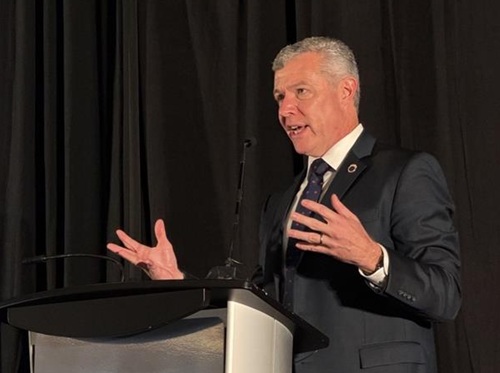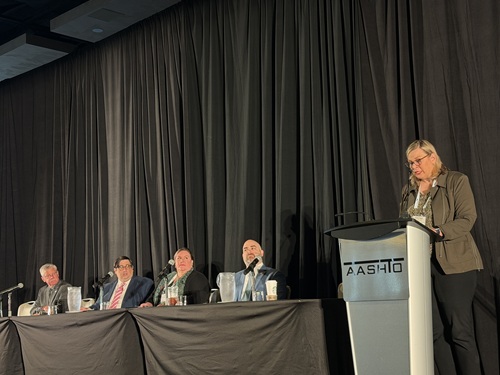During a roundtable held at the 2025 Transportation Research Board Annual Meeting in Washington, D.C., several state department of transportation chief executives discussed how the successes of the Infrastructure Investment and Jobs Act or IIJA – also known as the Bipartisan Infrastructure Law – can positively impact the next round of surface funding reauthorization, set for 2026.
[Above photo of Georgia DOT’s Russell McMurry by AASHTO]
The panel detailed how state DOTs continue to translate federal resources from the IIJA – now in the final stretch of its five-year lifespan – into tangible benefits to advance safety, mobility, and access across the country.
Panel moderator Russell McMurry – commissioner of the Georgia Department of Transportation and 2024-2025 vice president of the American Association of State Highway and Transportation Officials – stressed that state DOTs should celebrate the infrastructure accomplishments made due to the IIJA’s funding, which will “help us tell a better story going forward” regarding the funding levels needed for the next surface reauthorization bill.
“We need to show how state DOTs are delivering for their communities with IIJA resources; that helps us make the case going forward to Congress and the new administration why we need to continue to make this level of transportation investments,” he said.
“As we tell this story, we need to advocate for stable [surface transportation] funding at the same level of the IIJA if not more – because if we want to do more, it will take more to do,” Russell explained.
“We also need to think about reauthorization in terms of where we would be without the IIJA – meaning with 20 percent less funding,” he emphasized. “And as we talk about the critical nature of funding, we need to explain what it means in terms of the global competitiveness and safety and security of our nation.”

“You have to celebrate the success – because if you don’t remind people of successes, they will ignore and move past them,” added Michael Carroll, secretary of the Pennsylvania Department of Transportation.
A former state legislator, Carroll said state DOTs must be “aggressive” in telling the story of the IIJA’s successes. And you must “tell the story in the way average person will grasp it,” he added.
Carroll noted that no one really cares about the name of such legislation – whether it is called the IIJA or the Bipartisan Infrastructure Law. Rather, the key theme to convey to the public is “understanding the importance of these federal dollars” to the transportation systems they use.
“The beauty of IIJA is that is advanced all modes [of transportation] all of our residents rely on every day,” Carroll pointed out.
Carlos Braceras, executive director of the Utah Department of Transportation, added that discussing the successes created by the IIJA also means “finding opportunities to create ‘positive experiences’ regarding transportation” and how it affects the social fabric of people’s lives.

“We need to be proactive storytellers – helping the public understand how transportation can make their lives better,” he said. “We need to show them the importance of investing in our transportation systems. As much as we are engineers, we are also communicators; so we are the ones who need to make sure the public appreciates transportation.”
Nancy Daubenberger, commissioner of the Minnesota Department of Transportation, stressed that the “messaging” state DOTs need to conduct around the IIJA and subsequent surface reauthorization also needs to account for the impact of inflation over the last few years on the “buying power” of transportation funding.
“That’s why we need to maintain these [IIJA funding] levels if we are to keep making [transportation] advances for the future,” she emphasized. “That will help us talk about where these systems need to go in the future.”
Tracy Larkin Thomason, director of the Nevada Department of Transportation, noted that another benefit of the IIJA is that it allowed state DOTs to reduce some of the stress on financing infrastructure projects for local communities.
“The IIJA helped enhanced our partnerships with local agencies,” she said. “We also find that safety and economic development are big messaging points in our state in terms of the impact the IIJA funding had on daily life. Businesses will go somewhere else if they cannot get the workers or the access [to markets and raw materials] transportation provides. And without IIJA level funding, we will reach a point where we are just preserving what we have, but not providing much in the way of growing our systems for the future.”
That’s why Bradley Wieferich, director of the Michigan Department of Transportation, stressed that telling the story of the IIJA’s successes is also about changing the focus away from physical infrastructure to how people use that infrastructure in their daily lives.
Focusing on the benefits “will also help us figure out where infrastructure investments are most effective,” he said. “At the end of the day, yes, the IIJA was great – it allowed us to do more than what we could do before. But now we need to look at how we move forward from here, including how we create more sustainable [transportation] funding for the future.”
 Top Stories
Top Stories
Collaboration Touted at AASHTO’s Third Safety Summit
October 31, 2025 Top Stories
Top Stories

